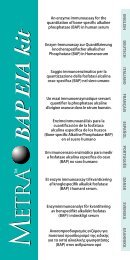Clinical and Technical Review - Tecomedical
Clinical and Technical Review - Tecomedical
Clinical and Technical Review - Tecomedical
You also want an ePaper? Increase the reach of your titles
YUMPU automatically turns print PDFs into web optimized ePapers that Google loves.
10<br />
Cartilage Degradation<br />
Chrondocyte:<br />
Chondroblasts trapped in lacunae develop into chondrocytes.<br />
Chondrocytes are important in the control of matrix turnover<br />
through production of collagen, proteoglycans <strong>and</strong> enzymes<br />
for cartilage metabolism.<br />
Proteins<br />
Matrix metalloproteinases:<br />
Are involved in the cleavage of Type II Collagen <strong>and</strong> the proteoglycan<br />
aggrecan. Three collagenases (MMP-1, -8,-13) are<br />
mainly responsible for primary cleavage of Type II Collagen.<br />
MMP-1, -8, -13 <strong>and</strong> 14 are involved in cleavage of the core<br />
protein of aggrecan.<br />
Cathepsin K:<br />
Protease produced by synovial fibroblasts, enzyme<br />
plays critical role in cartilage degradation (together with<br />
matrix metalloproteinases). MMPs perform extracellular<br />
predigestion of collagen, after endocytosis of large<br />
fragments, Cathepsin K degrades collagen <strong>and</strong> aggrecan in<br />
acidic lysosomes.<br />
Aggrecanases:<br />
Enzymes involved in cleavage of aggrecan.<br />
COMP:<br />
Cartilage Oligomeric Matrix Protein is an abundant cartilage<br />
glycoprotein also found in tendon <strong>and</strong> other tissues.<br />
Synthesized by chondrocytes, synovial <strong>and</strong> other skeleton<br />
cells. Intact <strong>and</strong> fragmented COMP in synovial fluid or<br />
serum is correlating to cartilage degradation in OA <strong>and</strong> RA.<br />
Cartilage metabolites <strong>and</strong> epitopes<br />
CTX-II:<br />
A 6 amino acid sequence epitope of the nonhelical C- terminal<br />
telopeptides resulting from Type II collagen degradation.<br />
C2C:<br />
C2C or COL2-3/4CLong epitope that specifically appears<br />
into circulation when Type II collagen degradation occurs.<br />
C1,2C:<br />
C1, 2C or COL2-3/4CShort epitope that appears into circulation<br />
when Type II but also Type I collagen degradation occurs.<br />
CS-GAG:<br />
Chondroitin sulfate glycosaminoglycans are bound at high<br />
densities, to a core protein forming the cartilage proteoglycan<br />
aggrecan molecule.<br />
Cartilage Synthesis<br />
Cartilage metabolites <strong>and</strong> epitopes<br />
Type II Procollagen:<br />
Secreted precursor of Type II Collagen. Extracellular cleavage<br />
results in N- <strong>and</strong> C-terminal propeptides.<br />
CP-II:<br />
Epitope of C- terminal propeptide, released during<br />
maturation of Type II Procollagen to Type II Collagen.<br />
Type II Collagen:<br />
The principal structural component of cartilage is an extensive<br />
network of Type II collagen molecules, arranged in fibrils.<br />
Collagen molecules consist of three chains to form a triple<br />
helix. Crosslinks between the chains <strong>and</strong> the molecules of<br />
collagen give collagen its strength.<br />
Proteoglycan Aggrecan:<br />
Responsible for the compressive strength of cartilage. Serve<br />
to trap <strong>and</strong> hold water to regulate matrix hydration. Monomer<br />
looks like test tube brush with keratan <strong>and</strong> chondroitin<br />
sulphate chains (= GAGs) bound to a protein core molecule.<br />
Monomers are attached via a link protein to hyaluronic acid.<br />
CS-GAG:<br />
Chondroitin sulfate glycosaminoglycans are bound at high<br />
densities, to a core protein forming the cartilage proteoglycan<br />
aggrecan molecule.<br />
Aggrecan epitope CS 846:<br />
Chondroitin native epitope, present on intact bioactive<br />
(“fetal-like”) proteoglycan only.<br />
PIINP:<br />
Epitope of Type II N-terminal propeptide, released during<br />
maturation of Type II Procollagen to Type II Collagen. PIINP<br />
has been postulated to play a role in chondrogenesis. It has<br />
been found to be synthesized by osteoarthritic chondrocytes<br />
in diseased cartilage <strong>and</strong> may serve as a specific arthritis<br />
biomarker that reflects an attempt by the chondrocytes to<br />
repair diseased cartilage.<br />
Proteins<br />
BMP1:<br />
BMP1 (Bone morphogenetic protein) is a protein that is<br />
capable of inducing formation of cartilage in vivo. It cleaves<br />
the C-terminal propeptides of procollagen I, II, <strong>and</strong> III <strong>and</strong><br />
plays an important role in collagen maturation.


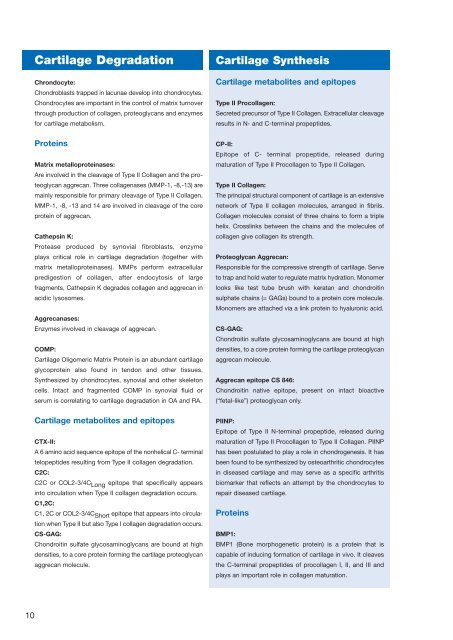
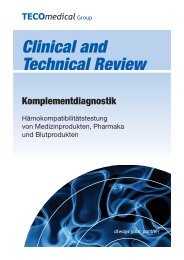
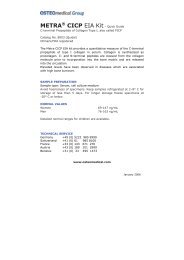
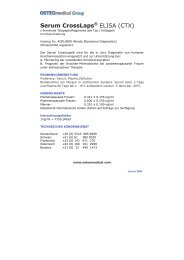
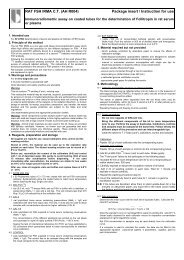


![PTH [Hormone Parathyroïdienne] Intacte ELISA](https://img.yumpu.com/1233682/1/190x245/pth-hormone-parathyroidienne-intacte-elisa.jpg?quality=85)
